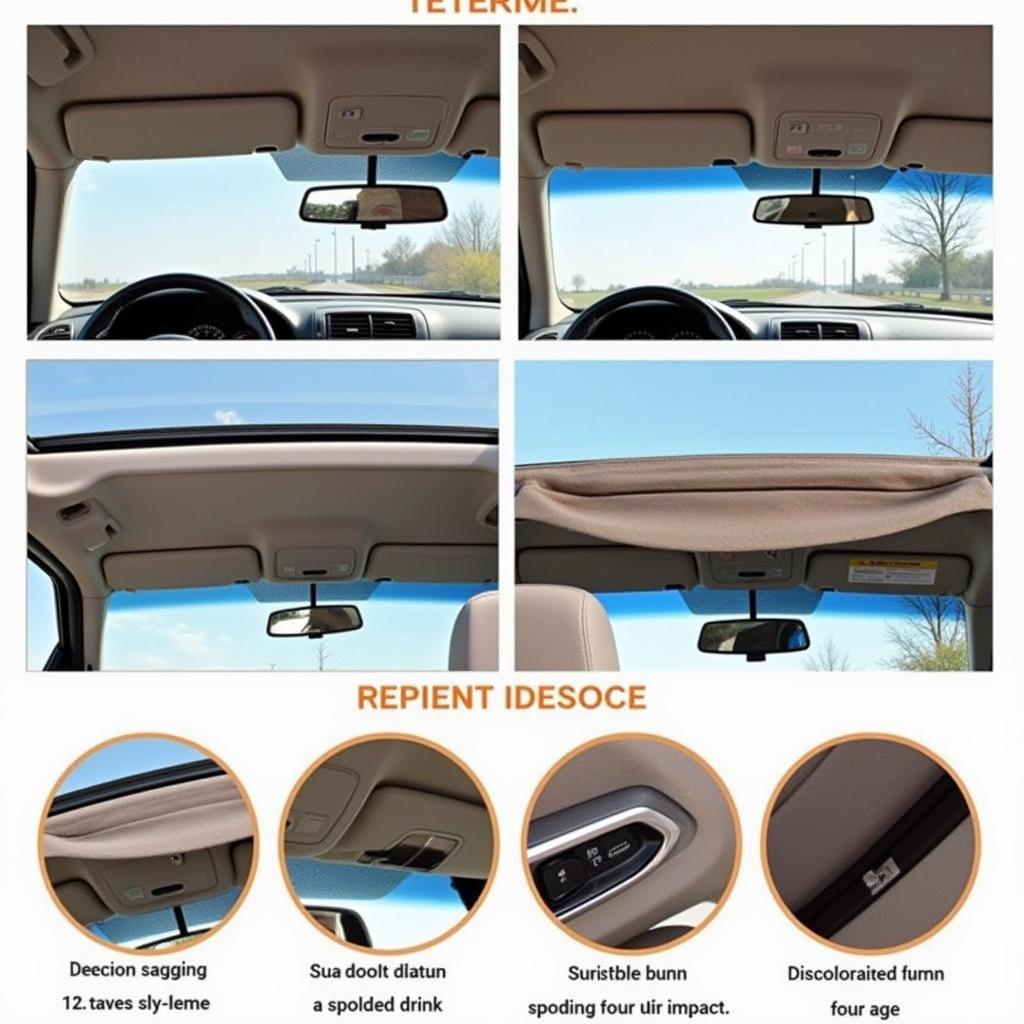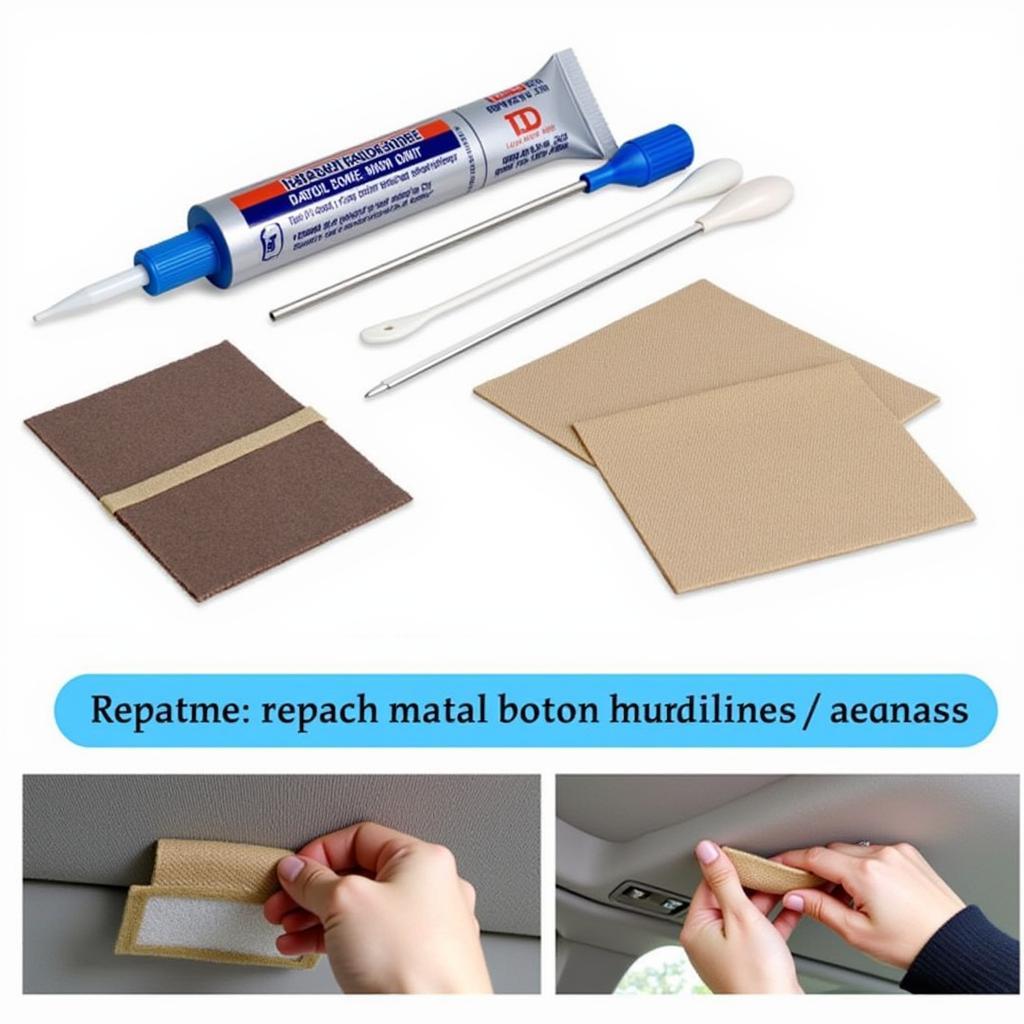Sagging or stained car upholstery ceilings can make even the nicest car look shabby. Fixing your car upholstery ceiling can dramatically improve the interior aesthetics and overall value of your vehicle. Whether you’re a DIY enthusiast or considering professional help, this guide provides valuable insights into how to Fix Car Upholstery Ceiling issues.
Understanding the Causes of Car Upholstery Ceiling Damage
Before diving into fixing your car’s headliner, it’s essential to understand the root cause of the problem. Common culprits include heat damage from the sun, humidity, age, and accidental impacts. Identifying the cause can help you choose the right repair method and prevent future damage. For example, a small tear might require a simple patch, while extensive sagging might necessitate a complete headliner replacement.
Common Culprits of a Damaged Headliner
- Heat: Intense sun exposure can weaken the adhesive holding the fabric to the backing board.
- Humidity: Moisture can cause the fabric to separate and sag.
- Age: Over time, the adhesive naturally deteriorates, leading to drooping.
- Impacts: Accidental contact with objects can tear or puncture the headliner fabric.
 Common Causes of Car Upholstery Ceiling Damage
Common Causes of Car Upholstery Ceiling Damage
DIY Fix Car Upholstery Ceiling Methods
Several DIY methods can effectively address minor to moderate headliner damage. These methods are often cost-effective and can be completed with readily available tools and materials.
Using Adhesive Spray
Adhesive spray is a popular solution for reattaching loose fabric. Ensure the area is clean and dry before applying the adhesive to both the fabric and the backing board. Carefully reposition the fabric, applying gentle pressure to ensure proper adhesion.
Repairing Tears and Holes with a Patch Kit
Small tears or holes can be repaired using a headliner repair kit. These kits usually contain fabric patches, adhesive, and a tool for smoothing the patch. Follow the kit instructions carefully for the best results.
How to Choose the Right Adhesive for your Car’s Headliner Material
Choosing the right adhesive is crucial. Using an incompatible adhesive can damage the fabric or be ineffective in holding it in place. Research the type of headliner material in your car and choose an adhesive specifically designed for that material.
 Using a Car Upholstery Ceiling Repair Kit
Using a Car Upholstery Ceiling Repair Kit
When to Consider Professional Help for Fixing Car Upholstery Ceiling
While DIY methods are suitable for minor repairs, extensive damage or complex headliner designs might require professional intervention. Professionals have the expertise and specialized tools to handle intricate repairs and complete headliner replacements effectively.
Signs You Need a Professional for Your Car’s Headliner Repair
- Extensive sagging or detachment
- Large tears or holes
- Complex headliner designs
- Water damage or mold growth
“A professional repair ensures a seamless and long-lasting fix, especially for complex headliner issues or high-end vehicles,” says John Peterson, Automotive Upholstery Specialist at Peterson’s Auto Interiors.
Preventing Future Car Upholstery Ceiling Damage
Taking proactive measures can help prevent future headliner problems. Using sunshades, parking in shaded areas, and regularly cleaning the headliner can significantly extend its lifespan. Addressing small issues promptly can also prevent them from escalating into more significant problems.
Simple Tips to Keep Your Car’s Headliner Looking New
- Park in the shade whenever possible.
- Use sunshades to reduce heat and UV exposure.
- Gently clean the headliner regularly to prevent dirt buildup.
Conclusion
Fixing car upholstery ceiling damage can revitalize your car’s interior. By understanding the causes, exploring DIY options, and knowing when to seek professional help, you can maintain a pristine and comfortable driving environment. For professional assistance or expert advice on car upholstery repairs, connect with us at Autotippro. Call us at +1 (641) 206-8880 or visit our office at 500 N St Mary’s St, San Antonio, TX 78205, United States.
“Regular maintenance and addressing small issues promptly can save you significant time and money in the long run when it comes to preserving your car’s interior,” adds Maria Sanchez, Lead Technician at AutoTipPro.
FAQ
-
What is the average cost to fix a car upholstery ceiling? The cost varies depending on the extent of the damage and whether you choose DIY or professional repair. DIY repairs can cost between $20 and $50, while professional repairs can range from $100 to $300 or more.
-
Can I use regular glue to fix my car’s headliner? It’s not recommended. Regular glue can damage the fabric and create a messy finish. Use a specialized headliner adhesive for optimal results.
-
How long does it take to fix a car upholstery ceiling? DIY repairs typically take a few hours, while professional repairs might take a day or more, depending on the complexity of the job.
-
Can I replace my car’s headliner myself? While possible, it’s a challenging task that requires specific tools and expertise. For most car owners, professional replacement is recommended.
-
How can I prevent my car’s headliner from sagging again? Park in shaded areas, use sunshades, and avoid exposing your car to excessive heat and humidity.
-
What are the best cleaning products to use on a car headliner? Use a gentle upholstery cleaner specifically designed for car interiors. Avoid harsh chemicals or abrasive cleaners that can damage the fabric.
-
Can I fix water damage on my car’s headliner? Minor water stains can often be cleaned. However, significant water damage or mold growth often necessitates professional cleaning or headliner replacement.




Leave a Reply